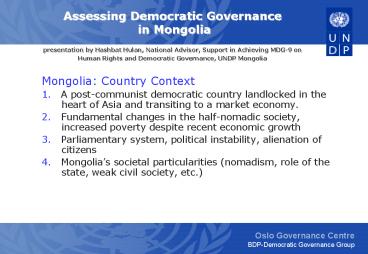Mongolia: Country Context - PowerPoint PPT Presentation
1 / 8
Title:
Mongolia: Country Context
Description:
A post-communist democratic country landlocked in the heart of Asia and ... Mongolia's societal particularities (nomadism, role of the state, weak civil society, etc. ... – PowerPoint PPT presentation
Number of Views:116
Avg rating:3.0/5.0
Title: Mongolia: Country Context
1
Assessing Democratic Governance in Mongolia
presentation by Hashbat Hulan, National
Advisor, Support in Achieving MDG-9 on Human
Rights and Democratic Governance, UNDP Mongolia
- Mongolia Country Context
- 1. A post-communist democratic country
landlocked in the heart of Asia and transiting to
a market economy. - 2. Fundamental changes in the half-nomadic
society, increased poverty despite recent
economic growth - 3. Parliamentary system, political instability,
alienation of citizens - 4. Mongolias societal particularities
(nomadism, role of the state, weak civil society,
etc.)
2
Assessing Democratic Governance in Mongolia
- Governance Assessment Context
- Mongolia hosted ICNRD-5 in September 2003. The
Conference adopted the Ulaanbaatar Declaration
and Plan of Action to strengthen democracy with
concrete tools such as DGI databases to monitor
democratic progress over time. - Government of Mongolia and UNDP Joint Action A
Follow-up to the ICNRD-5 project
institutionally located in the Ministry of
Foreign Affairs (June 2004 Nov 2006). - Direct access to funding, clear international
mandate, strong national government support to
piloting DGIs in Mongolia along with other
project outputs
3
Assessing Democratic Governance in Mongolia
- Governance Assessment Context
- 4. Stagnation in Democracy Process discontent
with government policies, entrenched corruption,
political gridlock, direct participation of
business groups in parties and government. - 5. The need for a more effective and clean state
with a better national ownership of political and
economic reforms. The need for informed
government decision-making.
4
Assessing Democratic Governance in Mongolia
- Nature of the Assessment
- IDEA State of Democracy Framework adopted as the
basis for assessment and modified to fit the
design requirements and Mongolias context.
Assessment by Mongolians for Mongolians with
international stakeholders. - First ever in-depth comprehensive assessment
based on mixed methods and the application of a
popular survey and core and satellite indicators.
- Core indicators Common values of democracy,
comparative opportunity, replicable, potential
for future time-line series of indicators. - Satellite indicators national characteristics,
contextually specific, better potential for
adaptation elsewhere, bridging universality and
particularity (Todd Landman)
5
Assessing Democratic Governance in Mongolia
Nature of the Assessment 5. DGIs Chart
6
Assessing Democratic Governance in Mongolia
- Process of the Assessment
- Selection of methodology, creation of research
team, design of - surveys and other methods, field operations,
expert evaluations, - mid-term review and stakeholders conferences,
development of a - case study, international experts conference,
publication, and - dissemination
7
Assessing Democratic Governance in Mongolia
- Outcomes and Challenges of the Assessment
- A new assessment tool was created national
ownership of democracy assessment and related
action plan ensured capacity-building for
researchers, government, NGOs and other
stakeholders enhanced political community
informed of the DGIs. DGIs have become a
comprehensive reference for all stakeholders. - ICNRD had the first ever follow-up in between
conferences with practical outputs on democratic
governance. - Challenges included difficulties during the
assessment process, institutional pros and cons,
initial lack of experience, political education
deficits among stakeholders, politicians in
particular. - The biggest challenge is to ensure the full
application of outputs in particular the Plan of
Action in reforming Mongolian political process.
8
Assessing Democratic Governance in Mongolia
Continuation of the Assessment on the Basis of
MDG-9
1. Mongolias MDG-9 was adopted in April 2005
by the Parliament with three main targets1.
Fully respect and uphold the Universal
Declaration of Human Rights and to ensure the
freedom of media and the right of the public to
have access to information, 2. Mainstream
democratic principles and values into life, 3.
Develop a zero-tolerance environment to
corruption in all areas of society. 2. MDG-9 is
to be furnished with indicators and a reporting
mechanism by mid-2008. The research team has
produced the first draft of MDG-9 indicators
based on DGIs that will be tested in two survey,
one by the MDG-9 Project, and the other by the
National Statistical Office of Mongolia in its
next years annual socio-economic household
survey. Thus, the process of institutionalizing
indicators is under way.

